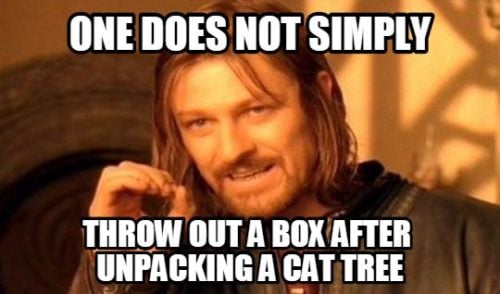Not all cats like boxes. In fact, only two of our three cats like boxes; the third one is ecstatic about them! He would sit in a box of any size. In addition to large boxes, he also dives into the smallest boxes he can squeeze a few parts of his body into, or he may sit “inside” a box cover with sides only a couple inches tall.
Most cat owners will agree that you only need to place a box on the floor and, within minutes, a cat will be in it. (If only putting a cat inside a carrier were equally easy!) But what is about boxes that draws cats to them? Let’s find out.
What’s with the boxes?

You are likely aware that cats like not only boxes but any tight place they can fit: inside a drawer, behind a cabinet, in between a TV and DVD player, etc.
What do all these places have in common with boxes? Most obviously, they are all enclosed spaces, and these can provide cats with their own feline fortresses.
If you are in a fortress with three walls surrounding you, you have only one side left to guard. For cats, the three walls of a box can provide similar safety. It can also give cats a sense of privacy or shelter from bad weather–even inside the living room.
Do wild cats love boxes?
It’s actually natural for cats to love boxes, and wild cats, including big ones, love them, too. Of course, you don’t find many boxes in the wild, but nature provides similar things for wild cats.
European and African wild cats are the closest cousins to our pet felines. Judging by looks and basic behavior, they are very similar to domestic cats, only more–how do you say it–wild. Beyond these differences, we can draw parallels between our pets and these smaller wild cat species.
European and African wildcats do not make their own burrows but use ones found readily in nature, such as the hollows of old or fallen trees, fox or badger holes, natural gaps between rocks, or the abandoned nests of large ground birds.
A burrow is the perfect place for wild cats to hide from other predators or bad weather. It’s a shelter, and a wild cat in danger is likely to retreat to one if it’s close by. It is only if there is no burrow nearby that he is likely to climb up a tree. Rearing kittens inside the safety of a burrow also increases their chances of survival.
House cats, on the other hand, do not need protection from predators. Keep in mind that their shelter-seeking behavior isn’t conscious but works on a genetic level. We could say that, on this level, your domestic cat isn’t aware that he or she is domestic. Besides physical threats from larger predators, a cat also uses these shelters for comfort and coziness.
By now, you might notice that humans aren’t much different from cats in shelter-seeking behavior. We also love to cover ourselves in a warm blanket, even if we do not feel threatened or stressed out. Though we don’t actively think about it, modern houses provide for humans almost everything that boxes do for cats: protection, shelter, comfort and warmth. There, we said it. A box for cats is like a house for us—a physical and emotional shelter from the world.
Embrace the box
With all this in mind, a cardboard box can provide a cheap and easy way to implement environmental enrichment for your cats. Of course, it’s okay to have expensive cat trees, shelves or beds, but when you buy a cat tree, you should not throw the packaging out.

You can place this empty box in the middle of the room for your cat to use. Position it normally or on its side for different experiences for your cat. If you want, you can cut holes of different sizes in the walls of the box so your cat can peek through them. Alternatively, you can use a smaller box with an opening in it to create a food puzzle. You could also place a blanket inside a box, put it on a window sill and let your cat use it as a bed.
The sky is the limit, so use your imagination. There are many different uses for boxes if you have cats in the house, and packing your stuff is not one of them. Because cats love boxes.
